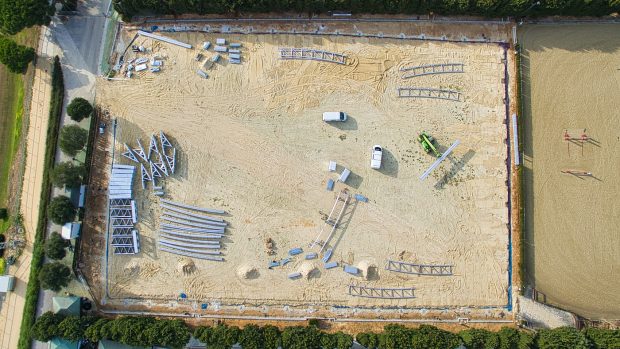Q: At the livery yard where I keep my horse we have an arena with a five-year-old silica sand and rubber surface. The drains have been down for 15 years.
The arena used to be usable all year, but recently soft patches have started to appear, which become holes when a horse treads on them. Do we just need a top-up of sand? Or is the problem likely to be the drainage? What would you recommend to improve the surface?
A: We spoke to two arena experts, who both agreed that, although it is difficult to give a precise answer without seeing the arena, your first step should be to check the school is draining properly.
“It sounds like the surface is becoming waterlogged, which leads to soft patches initially and eventually to the whole surface flooding,” says David Lovatt Smith, who has been the British Horse Society’s independent expert on arenas for the past 20 years.
“It becomes soft and deep to ride in because an excess of water acts as a lubricant and the particles of sand become like quicksand. It is probably caused by the drainage system underneath the riding surface becoming blocked or clogged and this will require the removal of the sand and the testing of the drains.
“More drains may have to be inserted or even an entire new drainage bed. If the sand is still serviceable, it may be re-used.”
Ross Jackson of Jackson Arenas explains how to check if the school is draining: “During the next rains, find the run-off drainage pipe and check that water is coming out.
“Next, scrape the surface back from over the problem area, pour a bucket of water on to the base and see if it drains; if the water doesn’t drain away it’s likely that the drainage layer is failing.
“As this arena has drained long-term, the problem is likely to be damaged membrane. Take back the stone base to expose the base membrane. This membrane keeps the drainage layer separate from the soil — particularly vital if you’re in a clay area. If the membrane is damaged and clay is oozing through, dig out the clay, lay new geotextile membrane, overlapping the existing good membrane and down into the dip, and fill back up to base level with stone.
“Occasionally a surface can hold water if it is very worn and has become compacted; another cause is a high organic content in the surface, caused by droppings being worked into it.
“To keep your arena draining to its best possible capacity, avoid turning horses out on the manège, as they can dig down and damage the base, pick up droppings immediately, rake the surface, although in hot weather only level the surface, as harrowing it will dry it out more quickly — and keep run-off pipes clear.”
- For expert arena advice, contact David Lovatt Smith (tel: 01323 833660) and Jackson Arenas (tel: 01647 24022) www.jacksonarenas.com
This Q&A was first published in Horse & Hound (18 January, ’07)



